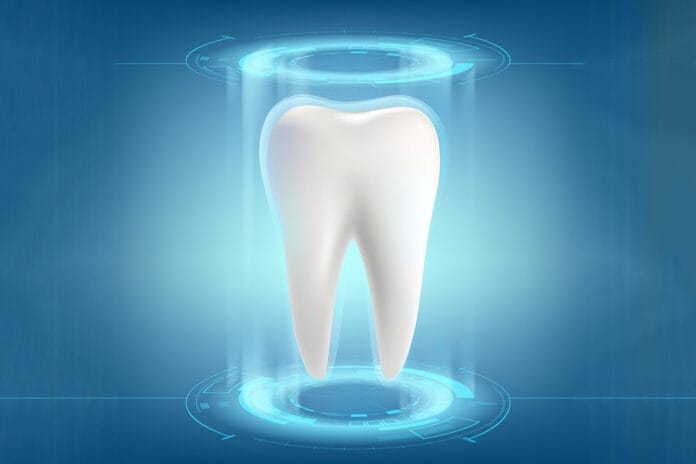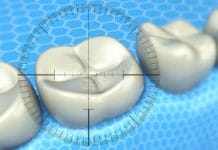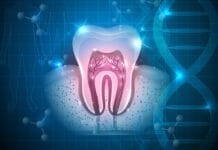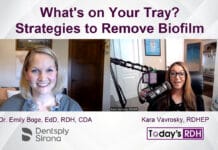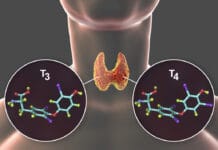The human tooth is no stranger to abuse. The human dentition has been taking a beating for years from everyday use and not-so-dental-friendly habits such as opening bottles. With the human bite force exerting 162 pounds of pressure per square inch (PSI), our teeth undergo extreme conditions that we, the owners, put them through. Due to stress levels on the rise in America, dentists report that people are breaking more teeth than ever, with bruxism as a contributing factor.1
All things considered, our teeth can survive some pretty harsh conditions because they are wonderfully made and coated with the most mineralized structure in the human body: enamel.2
The hard tissues of the human tooth are comprised of three layers: dentin, cementum, and enamel. The enamel is the outermost protective layer and is, remarkably, only a few millimeters thick. Enamel is mostly a composition of lattice-like crystals called hydroxyapatite but also contains 4% organic material: magnesium, sodium, fluoride, carbonate, and water.2 Hydroxyapatite is the bioavailable form of calcium used by our bodies to rigidify and strengthen the bone and the hard structures of our teeth.3
Dentists around the world use various materials to restore teeth when the enamel is compromised due to decay or breakage. While amalgam, a collection of precious metals, was used initially, a more esthetically pleasing resin-based matrix was introduced to the market in the 1960s. The resin-based matrix can be matched to the existing tooth enamel to help camouflage the restoration, making it more desirable. While esthetically pleasing, this material is simply not as strong as enamel.
Recreating Enamel
Scientists have longed to recreate tooth enamel’s hardness, durability, and strength as the cells, called ameloblasts, generate enamel die as soon as the tooth emerges from the gingiva.4 In 2021, a team of researchers began clinical trials on a lozenge containing genetically engineered peptides, or a chain of amino acids, along with phosphorus and calcium ions they hoped would rebuild the enamel.5 No updates have been given on this process.
However, when it comes to the synthetic production of enamel, the dental market was unable to provide a viable option. After many failed attempts, scientists have successfully created a synthetic version that may just be even more durable than the real thing at the University of Nottingham in England. Researchers involved in this study explained enamel’s makeup as intricate and difficult to mimic, stating it contained nested modes of organization like wool fibers spun into yarn and then knitted into a cable knit sweater.6
Researchers went on to state that the most complicated aspect of recreating enamel is devising a strong enough substance to resist dents yet elastic enough not to crack by replicating the detailed levels of organization. Past studies have attempted to use peptides to build these proteins.6
The most recent study used a different method to create the crystalline wires comprising enamel. Researchers used extreme temperatures to coax the wires in an orderly fashion. As with other studies, the scientists used hydroxyapatite to build these wires and then encased those wires with a malleable metal-based coating. Human enamel naturally contains a magnesium-rich coating; therefore, researchers wanted to simulate this durability but chose to upgrade to zirconium oxide, which is often used in restorative dentistry and is extremely strong. This method created a material resembling enamel that could be cut into shapes with a diamond-bladed saw.6
Tougher than Real Enamel?
The study went on to test the hardness of the structure by applying pressure until it fractured, as well as testing the ease of indention with a diamond tip. These tests resulted in artificial enamel outperforming natural enamel in six different areas. What is yet to be tested is how well it can bond to natural tooth structure, which is pivotal. The method in which it is created is also something that imposes an issue for dental offices to mimic, given it requires heating to 300 degrees Celsius, carefully freezing, and then cutting into shape with a diamond saw.6
If this material can be utilized, some researchers believe it could go beyond tooth repair and serve as “smart” teeth. One researcher, Nicholas Kotov, a chemical engineer, foresees artificial enamel as a way to help detect acetones on the breath found in patients with diabetes, adapting to the mouth’s microbiome, and sensing inflammation.4
In Closing
While this synthetic material may never find its way into the human mouth, it creates an opportunity outside dentistry. Researchers see artificial enamel as a way to protect electronic chips from drops or jostling or to be used in earthquake-safe building materials.
The development of artificial enamel still has obstacles before reaching the finish line, and this discovery certainly makes the possibility more obtainable. I think it is fair to speculate that this new material would come with a hefty price tag and may not be affordable or accepted by insurance for quite some time, making it unobtainable for many. As a dental hygienist, I would be curious to know if this material would require special precautions or instruments for prophylaxis. Either way you view this topic, it only solidifies how important protecting and caring for our natural enamel really is.
Before you leave, check out the Today’s RDH self-study CE courses. All courses are peer-reviewed and non-sponsored to focus solely on high-quality education. Click here now.
Listen to the Today’s RDH Dental Hygiene Podcast Below:
References
- Ficton, J. (2021, April 16). Stress-Induced Teeth Grinding Increases TMJ Issues. Head & Neck Pain Clinic. https://mhnpc.com/2021/04/16/stress-induced-teeth-grinding-increases-tmj-issues/
- Pepla, E., Besharat, L.K., Palaia, G., et al. Nano-Hydroxyapatite and Its Applications in Preventive, Restorative and Regenerative Dentistry: A Review of Literature. Annali di Stomatologia. 2014; 5(3): 108-114. https://www.ncbi.nlm.nih.gov/pmc/articles/PMC4252862/
- Byrum, K. (n.d.). SCIENCE + TECH: Nano-hydroxyapatite vs. Fluoride. American Student Dental Association: Contour. http://digitaleditions.walsworthprintgroup.com/publication/?i=654899&article_id=3633871&view=articleBrowser&ver=html5
- Young, L.J. (2022, February 8). This New Synthetic Tooth Enamel is Even Harder than the Real Thing. Popular Science. www.popsci.com/health/artificial-tooth-enamel
- Trials Begin on Lozenge that Rebuilds Tooth Enamel. (n.d.). University of Washington School of Dentistry. https://dental.washington.edu/trials-begin-on-lozenge-that-rebuilds-tooth-enamel/
- Wheeler, G. (2022, February 3). New Artificial Enamel is Harder and More Durable than the Real Thing. Science. https://www.science.org/content/article/new-artificial-enamel-harder-and-more-durable-real-thing

